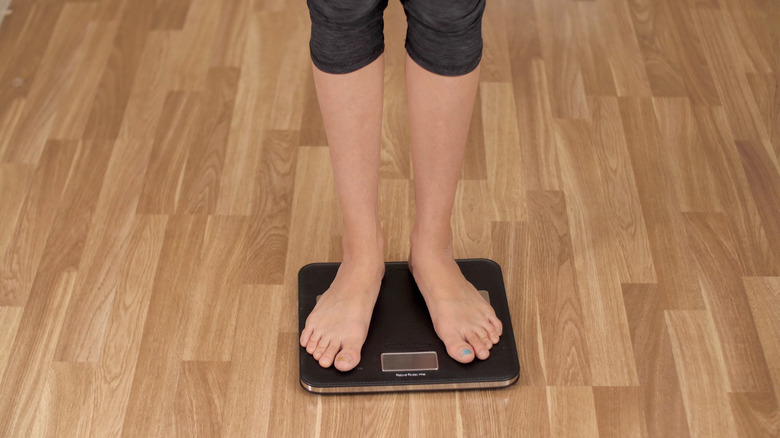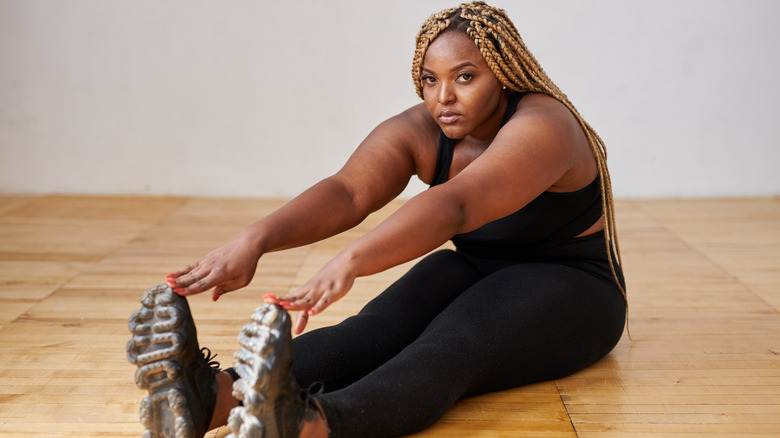Signs You Probably Need To Change Your Workout Routine
Well, congratulations, and look at you winning at the workout game! After searching long and hard for the fitness routine that gets you psyched and keeps you motivated, you have finally found it. And now that you have, by all means, go ahead and enjoy every endorphin-soaked minute of it — and definitely plan to stick with it ... at least for the time being.
The paradox of discovering your perfect workout routine is that what is perfect for you right now might not be perfect for you over the long haul. And just because you have finally settled into a solid workout routine that you enjoy and is working for you right now doesn't mean that you've got it figured out for all time going forward. Sticking to the same routine day after day, year after year, may not be desirable or even possible. And if you think about it, shouldn't the fact that you're using the words "settled" and "routine" offer somewhat of a spoiler alert?
While we're not saying there's some sort of expiration date on your favorite athletic pursuits, what we are saying is that there are good reasons to change it up now and again, at least in minor ways. The question is, how do you know when it might be time to change up your workout routine? Read on for some of the signs that it's time to shake things up.
It's been a month since you've made any changes to your workout
There's nothing like discovering a workout routine that really feels right, right? And if you've just started a new routine, you might even begin to feel the benefits within two weeks, according to personal trainer Jamie Logie (via Healthline). Within six to eight weeks, "you can definitely notice some changes," she added, and within three to four months, "you can do a pretty good overhaul to your health and fitness."
There are benefits of making changes — even subtle ones — to your workout routine as you begin to feel and see those results. In fact, OG celebrity fitness trainer Jack LaLanne once said that his secret to maintaining his workout routine over the long haul (and it was a long haul considering he was working out well into his 90s) was making changes to it every three to four weeks (via Bicycling).
"LaLanne was one of the first advocates of switching-up routines to keep his muscles constantly challenged and preventing too much muscular adaptation," according to Muscle Prodigy. "He changed his exercise routine every 30 days, switching up both his strength and cardio workouts." Notice that we didn't say he ever "stopped" exercising, just that he made changes to his routine.
You've hit a weight loss plateau
If weight loss is one of your goals in exercising, consider yourself lucky because you have a built-in litmus test for determining whether it's time to change up your workout routine: the scale. If it's not budging and you've been sticking to your eating goals, you can consider that a good time to switch up your same-old workout routine. "Unfortunately, your metabolic rate slows down as you lose weight," Healthline, explained, citing a 2010 study published in Obesity Review. That study found that for every pound of weight loss, the 2,900 people in the study burned, on average, nearly 7 fewer calories.
"When you do the same activity all the time, your body gets used [to] it and becomes very efficient," explained physician Arnold Lee to One Medical. "Eventually, that adaptation will mean that you burn fewer calories even when you're doing the same amount of exercise." One way to counteract this is to increase the amount of weight or resistance of any weight-bearing exercise you're already doing. Likewise, you can also add a workout or two per week or increase your workout intensity.
You've hit a fitness plateau
Even if you're not trying to lose weight, your fitness progress can speak volumes, according to physical therapist Dr. Wendy Noakes. "In order for muscles to continue to grow and get stronger, you have to give them more or different stimulus," Noakes explained to Health Digest. "When it comes to weight-bearing exercise, the easiest and most common way to do this is to increase the weight you are using for each set," and this can be a good solution if you really enjoy the precise workout routine you've been doing and don't really "feel" like changing it up. Similarly, Noakes suggests that you change the tempo of your lifting by swapping in some super-slow lifting. Or you can change the angle at which you're lifting weights (e.g., back squat versus front squat).
If you're not noticing gains or if you feel like you might even be backsliding, another solution is to try a "whole other workout" to challenge your body to move in different ways, Noakes added. For example, if you've been doing Crossfit and you're finding you're still struggling to do a pullup, you might consider trying vinyasa-based yoga, which offers many opportunities for developing functional upper body strength. Likewise, if you've been running on a track but not getting any faster, you could switch it up by adding some hills.
You're pregnant
"Working out while pregnant is safe for most moms-to-be," registered nurse Kandis Lake explained in an article for Babycenter. "But it's important to make sure you're exercising in a healthy way" for your changing body. And not all workout routines are considered healthy for women during pregnancy. For example, if your workout routine involves a lot of physical contact — such as basketball, soccer, or boxing — you may want to consider switching to something that doesn't involve a risk of getting hit in the abdomen. The same is true if your workout routine involves a risk of falling, such as it does with downhill skiing, gymnastics, surfing, and horseback riding.
Speaking of falling, since your center of gravity shifts rapidly as your pregnancy progresses, it may also be prudent to make changes along the way to accommodate a newfound but temporary loss of balance. For example, cycling early in a pregnancy can be fine. However, later in the pregnancy, when balance can become an issue, there's a greater risk of falling and injuring yourself.
Another pregnancy-related reason for changing up your workout routine is that as your pregnancy progresses, it's common for the feet to swell. If your exercise routine involves heavy pounding on your feet (running or jogging, for example), you may experience less discomfort by switching to non-impact exercise such as yoga and pilates, which also offer the benefit of not requiring you to put on sneakers.
Your workouts are starting to feel easy
Remember when you were first getting started with your workout routine and every day presented a new challenge? Some days, perhaps it felt like your heart might beat out of your chest. Other days, your limbs might have felt like they were made of lead. So you might think that the day you start to notice that your workouts have become "easy" is the day you're finally found your workout sweet spot.
While there's something to be said for coasting, if you stay in workout autopilot for too long, you may find yourself losing ground or losing interest, according to Health. The site pointed out that some of the signs your workout has become too easy include a lack of that feeling of accomplishment and a feeling like you still have more to give at the end of a workout (such as if you feel inclined to work out multiple times per day).
If you're starting to notice these signs that your workouts are becoming so easy, you can remedy it by ramping up your workout routine with either an increase in time spent or an increase in your intensity level.
Your workouts are leaving you too tired
Just as you might want to consider changing up your workout routine when you start to find it has become a little easy and comfortable or if you're not making any new fitness gains, you might also want to consider changing up your workout routine if you start to notice it's becoming harder.
When you first start a workout routine, you'll likely notice positive changes pretty soon after, according to fitness trainer Jamie Logie (via Healthline). After a while, it might even start to seem easy (via Health). But then there may come a time when the same old workout is leaving you more tired, more sore, and more spent than it used to. While it could be normal signs of aging or a sign of illness or infection, it could also be a sign that you've been doing the same routine the same way for too long, according to Healthline.
If your once-doable workout has become increasingly less doable, you might be putting yourself at risk for overuse injuries or burnout — or both. "Weightlifting, cardio, and HIIT workouts can all lead to burnout," as can training for a single-sport, the site confirmed. The solution here is to mix in some complementary cross-training such as swimming with running or body-weight exercises with weight-lifting.
You've had an overuse injury in the past
What could possibly be wrong with wearing protective knee brace over one knee? Maybe nothing, but maybe if you're in need of a protective knee brace while doing your daily run, it's a sign to change your workout — to something that involves either less running altogether or perhaps just a different kind of running (for example, alternating treadmill or track runs with trail runs). "Sometimes doing the same thing over and over again, no matter how good it is for you, can lead to an overuse injury," physical therapist Wendy Noakes explained to Health Digest.
Overuse injuries occur from "doing lots of repetitive motions, such as running, hitting a tennis ball, kicking (in kickboxing or martial arts classes), or performing the same swimming stroke," according to physician Arnold Lee (via One Medical). By mixing up your activities, you give those overused muscles, joints, and ligaments a chance to rest and recover before putting them into action again. In addition, doing the same workout over and over again can also lead to the under-use of certain muscles, which can later contribute to overuse injuries over time.
You've had a sudden injury
"If you find yourself with a sudden injury — i.e., an acute injury — from any cause, even if it is not directly related to your workout routine, you should definitely consider changing things up, even temporarily while you're healing," physical therapist Wendy Noakes advised Health Digest. Even if your injury was caused by something completely unrelated to your workout routine — such as a car accident or even twisting your ankle while stepping off a curb, you run the risk of exacerbating your injury by continuing to do the same workout routine you were doing before you became injured, particularly if your workout routine directly stresses the injured area.
However, even if your workout routine does not directly put stress on whatever part of your body you have injured, you may heal faster if you allow your body — and not just the injured body part — to rest, according to Verywell Fit. If you've suffered an acute injury that has put you under a doctor's care, then you may be best off speaking to your doctor about what you should be doing to heal most efficiently and effectively, and that may include modifying your workout routine or taking a break from it entirely.
Should you change your workout routine if you catch a cold?
"Mild to moderate physical activity is usually okay if you have a common cold and no fever," according to physiatrist Edward Laskowski, and "exercise may even help you feel better by opening your nasal passages and temporarily relieving nasal congestion" (via Mayo Clinic). However, if your cold symptoms are "below the neck," such as "chest congestion, a hacking cough, or upset stomach," Dr. Laskowski suspects you may be better off by reducing the intensity and length of your regular workout, such as by going for a brisk walk rather than a run. And if you have a fever, fatigue, or muscle aches, then you could be better off skipping your workout altogether.
"If you feel miserable, take a break," the doctor advised. A few days off from exercise when you're sick shouldn't affect your performance. Resume your normal workout routine gradually as you begin to feel better. Check with your doctor if you aren't sure if it's OK to exercise."
You're getting sick often
One cold does not a health concern make, but catching colds repeatedly in a short period of time can be a sign you're overtraining, which itself is a sign it's time to change your workout routine, according to Healthline. The site pointed out that "along with feeling run-down, you may find you get sick more often. You may also be prone to infections, mild illnesses, and upper respiratory tract infections (URTIs)."
While exercise is generally good for your body, intense exercise is known to put a strain on the body, which can tax the immune system, immunologist Purvi Parikh explained to Shape. That is one reason why repeat bouts of intense training, in the absence of sufficient recovery time, may actually put you at greater risk for illness and infection, according to a 2017 study published in the Journal of Applied Physiology.
If you find yourself becoming increasingly run-down — particularly, if you keep catching colds and infections (even minor ones) — it could be a sign that your workout routine needs a bit of tweaking in favor of sprinkling in some days involving less intense effort.
You've become bored of your fitness routine
One of the most obvious signs that your workout routine is in need of a change is when you're finding yourself becoming apathetic, uninspired, or even flat-out bored by it. Now, you might be wondering, how can you tell the difference between being bored of your workout routine versus just not being a big fan of working out? Well, physical therapist Wendy Noakes told us, "Fitness should be fun and not a chore. Don't stick to something just because you read or someone told you that it's good for you."
And don't just stick to something because it had been working for you in the past. If your workout is suddenly starting to feel "blah," it's something to keep an eye on. If that "blah" feeling continues, it's going to become more and more difficult to motivate. And discipline is one thing, but forcing yourself to do something you've grown to dislike is another. "Staying consistent with your routine is going to be much more effective long term than doing something you don't enjoy and quitting after a few weeks or months," Noakes explained.
You've reached a fitness goal
Let's say you've been training for the last few months to complete a marathon — and then you did it. You've never felt fitter or more accomplished, which makes sense given that setting fitness goals is a great way to get and stay motivated and keep your workout routine fresh, according to the Australian Fitness Academy (AFA). But what now? Should you continue with the same routine since it's already been proven to work for you?
Your marathon training clearly benefitted you, but motivating you all along was the desire to finish the marathon. Without something concrete to continue to focus and motivate you, your workout routine might begin to feel aimless. "The mind is an incredible tool but subconsciously it can deceive us," wrote AFA. "For example, if you don't like leg days, it's easy to forget the last time you did a leg strength session. Without a goal you might think 'I did a leg session last week, that's okay,' but in actual fact it was 2 weeks ago, and now you've neglected it again and your overall strength is lacking." Accordingly, once you've achieved an important fitness goal, you might be best served by setting another one — and tweaking your workout routine with your new goal in mind.
Your workouts are seriously starting to interfere with your life
Yes, it takes discipline to commit to a workout routine, but if you find that your workout routine is interfering with your life in a way that is leaving you feeling isolated or alienated from your friends and family, then it might be time to consider a change. Indeed, if your workout routine leads you to frequently cancel social plans you made (which suggests you wanted to make those plans but felt compelled to change them), that could be a sign that it's time to re-evaluate not only your workout routine but also your relationship to exercise, according to fitness expert Jessica Corbin. "You know you are a bit obsessed with fitness if the other vital aspects of life, including family, friends, work, community and having fun always take a back seat to your workouts," Corbin explained to Psychology Today.
Other signs that your workout routine is interfering with your life include constantly ruminating about your workouts and using workouts to "make up for" dietary missteps. Even more worrisome is if you find yourself blowing off work obligations or putting yourself in potential danger for the sake of a workout. In addition, if you keep hearing — consistently and persistently — from your family and friends that you may be overdoing it, you really may be. In that case, it's worth taking a pause to check in with yourself (via Healthline).













